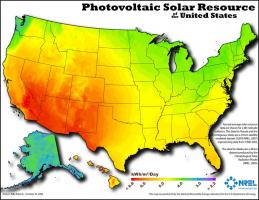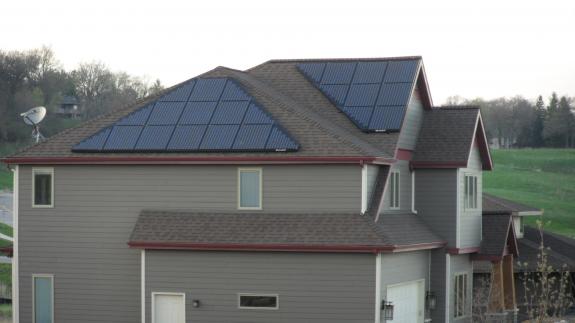Recent solar production
| Date | Energy (kWh) | Max Power (W) |
| 2025-10-12 | 7.69 | 3052 |
| 2025-10-11 | 16.76 | 2364 |
| 2025-10-10 | 10.48 | 3059 |
| 2025-10-09 | 16.93 | 2511 |
| 2025-10-08 | 17.01 | 2379 |
| 2025-10-07 | 16.15 | 2333 |
| 2025-10-06 | 2.28 | 610 |
| 2025-10-05 | 14.97 | 2620 |
| 2025-10-04 | 15.19 | 2313 |
| 2025-10-03 | 14.27 | 2447 |
| 2025-10-02 | 15.23 | 2170 |
| 2025-10-01 | 12.36 | 2612 |
| 2025-09-30 | 14.65 | 2240 |
| 2025-09-29 | 15.64 | 2179 |
| 2025-09-28 | 16.82 | 2345 |
| 2025-09-27 | 16.35 | 2611 |
| 2025-09-26 | 15.73 | 2220 |
| 2025-09-25 | 16.75 | 2485 |
| 2025-09-24 | 4.40 | 2574 |
| 2025-09-23 | 8.28 | 2788 |
| 2025-09-22 | 9.71 | 3101 |
| 2025-09-21 | 9.19 | 2782 |
| 2025-09-20 | 7.13 | 3064 |
| 2025-09-19 | 9.79 | 2735 |
| 2025-09-18 | 12.18 | 2954 |
| 2025-09-17 | 15.22 | 2181 |
| 2025-09-16 | 15.80 | 2206 |
| 2025-09-15 | 16.26 | 2274 |
| 2025-09-14 | 14.15 | 2284 |
| 2025-09-13 | 15.05 | 2491 |
Why we chose solar
A solar system was one of the first things we considered when we began the building process, because it's something that comes to mind right away when discussing renewable energy. Right from the start when we were talking about "green" building, people were asking about solar panels.
Along the way, even though our primary focus was on other techniques, we have been making preparations for a "future" solar system. With the house construction on budget and the sale of our existing home arranged, we were able to take the next steps to commit to the solar installation.
Applications of solar
Solar energy systems are most commonly associated with the sunny deserts of the Southwest, but we have them in Wisconsin as well. True, we will harvest less sunlight because we have more average cloud cover -- about 1/3 less energy will be collected. This map is from the National Renewable Energy Laboratory:

There are two primary uses of solar energy in residential applications: water heating and electrical generation (photovoltaics, or PV).
Solar hot water is actually the more cost-effective technology, in terms of "payback." Pipes would be run from a storage tank to a collector on the roof. These pipes would circulate water between a storage tank and the collector, where it would be heated. (Or, in climates susceptible to freezing, an antifreeze solution would be circulated, and the water would be heated with a heat exchanger in the storage tank.) More info on solar hot water: here and here.
In our case, we already have two technologies to reduce the energy required to heat water. The desuperheater on our geothermal heat pump will generate domestic hot water, substantially so in the cooling season -- right when solar energy is the greatest. (More about the geothermal's hot water generator is in my somewhat ironically-titled blog post.) Add to this the drain water heat recovery system, which although it doesn't actually generate hot water, will recapture energy that would otherwise go down the drain.
Between these technologies and an efficient natural gas water heater, the incremental benefit for us to implement solar hot water heating would be reduced. Therefore, we chose electrical generation.
Our solar installation
Planning
Fixed solar panels should be mounted as close to due-south as possible, for maximum average sunlight. Our lot, however, is aligned so that the larger roof areas face east and west. (Had solar energy been a primary consideration, we would have chosen another lot.) We did design the house to increase the south-facing roof area, by adding a hip roof and the front gable. This got us about 350 square feet of usable space. Additionally, in planning the landscape, we are choosing low-growing ornamental trees on the south side to avoid shading the panels.
Preparing
We had our electrician run two conduits up from the basement to the attic, to accommodate the future wires of the solar system. Then we met with Andrew Bangert from H&H at our house, right before the drywall and insulation went on, to make sure we were doing everything right. Andrew recommended the "Soladeck" roof-mount box, which made even more sense -- when we added solar later, there would be no need to go into the attic at all. We had H&H install one Soladeck on each of the two south-facing roofs. (Our electrician had already run the other conduits, which is fine... I am sure that some day we'll use them for some yet unforeseen technology.) Cost: $500 for two Soladeck boxes installed with conduit to the electrical panel.
We also had our electrician swap out the one-socket electric meter for a two-socket meter. We will need this for the incentive of selling back our solar energy to the utility, explained below. Cost: $350 installed.
Finally, working with Matt Acker we requested that there be no protrusions on the south-facing roof. Matt made sure that the HVAC and plumbing crews put all vents, pipes, etc., on another part of the roof. This prevents interference with the installation and shading of the panels. No cost.
Site Assessment
The recommended first step in a solar install is a formal site assessment which calculates panel area, shading, etc. We received the equivalent of an assessment when Andrew Bangert from H&H Solar Energy Services came out as described above. We were fortunate to have received his recommendations before the drywall and insulation were installed, to do it right the first time and avoid expenses down the road. Note: an incentive to help defray the cost of a site assessment is available from Focus on Energy.
Permission
The deed restrictions for Middleton Ridge state that permission must be received from the developer for any solar panel system. Using a design for triangular panels provided by H&H, we presented this to the developer and received approval. (See the note below under "Solar laws" concerning land restrictions that prohibit solar and wind generation.)
Application for rebate
A substantial rebate (around $5,200 for our system) is available from Focus on Energy. Prior to ordering equipment, Focus must approve our application to render us eligible for this rebate. We received our approval from Focus on Energy on October 23, so it's full speed ahead toward our installation.
Installation
Complete! H&H solar took a total of 4 days to install the panels and inverter. The system was commissioned by Madison Gas and Electric on November 17, 2009.
Solar laws
Limitation on private land use restrictions
Wis. Stat. § 236.292, voids all restrictions on platted land that prevent or unduly restrict the construction or operation of solar and wind energy systems. The covenants for Middleton Ridge require approval from the developer/architectural control committee for solar installations. The developer has been cooperative with us through all phases of our construction and approved the proposed solar installation without even a hint of a struggle.
Right to sun
Wis Stat. § 700.41 and Wis. Stat. § 844.22 address neighboring structures and vegetation that interfere with the operation of solar and wind energy systems.
Using our own solar vs. selling it to the utility
Madison Gas and Electric will purchase electricity generated from the solar system for $0.25 per kWh. They offer all their customers the opportunity to pay a small surcharge to purchase their energy "from renewable sources" and any solar system in the program becomes part of that mix. We will be participating in this buy-back program and paying the surcharge of $0.01 per kWh on our own electric bill to purchase our own energy "from renewable sources." In our area this is about 99.9% wind energy and 0.1% solar.
I put "from renewable sources" in quotes because electrons don't know whether they were set in motion from solar panels, wind farms, nuclear, or coal plants. The amount of electricity entering our home from our solar panels, remote wind farms, and the dirtiest coal plant on the grid would be no different if we participated in the buy-back or renewable energy programs. (The only way for us to guarantee that all of our actual used power was from renewable sources would be to disconnect from the grid.)
Despite the physics of the situation, these utility-offered renewable programs still make sense. The utility still purchases energy equivalent to our usage from the renewable source, and this reduces the power that must be generated or purchased from the non-renewable sources. Improving the mix benefits everybody on the grid and not just the participant, but that's OK with us.
Cost breakdown
| Description of Component | Total Cost |
| Soladeck boxes and conduit to basement electrical panel | $500 |
| Two socket electric meter | $350 |
| Solar site assessment | Incl. |
| Solar installation - panels, inverter, installation, etc. | $21,840 |
| Gross cost | $22,690 |
| Focus on Energy rebate ($1.50 per est. annual kWh) | ($5,189) |
| Focus on Energy bonus for Energy Star home | ($500) |
| Net cost after Focus on Energy incentives | $17,001 |
| Federal tax credit - 30% of net cost after incentives | ($5,100) |
| Net cost after all incentives | $11,901 |
An additional incentive is post-installation power buy-back from the utility at $0.25 as noted above. At an estimated annual production of 3459 kWh, we can expect about $864.75 of actual cash returned to us per year. Divide $11,901 / $864.75 = 13.76 years to "break even." (Solar panel lifetime is estimated to be 20 years or longer.) UPDATE: For both 2010 and 2011, the panels have exceeded our estimates and generated over $1000 per year!
Among all of the technologies and techniques we have incorporated into our home, the solar system is the one with the longest payback period. The "less sexy" air sealing, insulation, drain water heat recovery, energy efficient light fixtures, and geothermal system all provide a faster return on investment. Solar electric in Wisconsin is one of those things that you do more out of a sense of environmental stewardship than you do for the money. However, even 13-14 years is less than the life expectancy of the system, and so we expect that it will indeed pay for itself during the time we are planning to stay in this home.
List of solar incentives
- 30% tax credit (Federal Goverment / IRS)
- Property tax exemption for solar equipment (State of Wisconsin)
- Clean power buy-back program (Madison Gas & Electric)
- Solar electric cash back (Focus on Energy)
